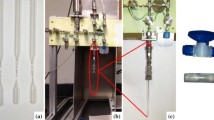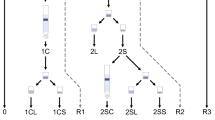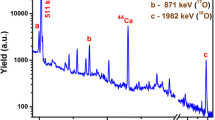Abstract
A method has been developed to eliminate environmental variables and macroscopic diffusive transport to obtain a direct measurement of radioxenon’s emanation coefficient, K, from a solid matrix. The emanation measurement apparatus (EMA) utilizes neutron activation and a cryotrap** technique with LN2, which increased gas trap** efficiency from 4 ± 3 to 78 ± 7%. Emanation values are measured by γ spectroscopy with a High Purity Germanium detector. Preliminary results from EMA demonstrated the capability of this new process to make reproducable emanation measurements with quantifiable uncertainty. Initial experiments produced U3O8 radioxenon emanation coefficients of 0.016 ± 0.002 for 133Xe and 0.025 ± 0.002 for 135Xe at temperatures ranging from 20 to 80 °C.







Similar content being viewed by others
Notes
EMA is capable of operating with pressures up to 1000 torr. However, this method was designed to measure trace quantities of radioxenon. In an evacuated system, the emanated gas release in EMA was not more than 15 torr for the irradiated 0.5 g of uranium oxide.
References
CTBTO Preparatory Commission (2018) The treaty. https://www.ctbto.org/the-treaty/. Accessed 14 Jan 2018
CTBTO Preparatory Commission (2018) Map. https://www.ctbto.org/map. Accessed 14 Jan 2018
Johnson CM (2016) Radioactive xenon and argon production and transport in the environment. University of Texas at Austin, Austin
Sivels C, McIntyre J, Bowyer T (2017) A review of the developments of radioxenon detectors for nuclear explosion monitoring. J Radioanal Nucl Chem 314:829–841
Hassan NM, Hosoda M, Ishkawa T et al (2009) Radon migration process and its influence factors. Jpn J Health Phys 44:218–231
Semkow TM (1990) Recoil-emanation theory applied to radon release from mineral grains. Geochim Coosmochim Acta 54:425–440
Robertson JB (1969) Behavior of xenon-133 gas after injection underground: molecular diffusion, materials balance, and barometric pressure effects. Idaho Falls. Clearinghouse for Federal Scientific and Technical Information, Springfield, VA
Olsen KB, Kirkham RR, Woods VT et al (2016) Noble gas migration experiment to support the detection of underground nuclear explosions. J Radioanal Nucl Chem 307:2603–2610. https://doi.org/10.1007/s10967-015-4639-7
Nazaroff WW (1985) Radon transport from soil to air. Rev Geophys 30:137
Ferreira A, Lobo L (2008) The sublimation of argon, krypton, and xenon. J Chem Thermodyn 40:1621–1626
Matzke H (1980) Gas release mechanisms in UO2—a critical review. Radiat Eff 53:219
Blood M (2018) A method for measuring radioxenon emanation with cryotrap** and γ spectroscopy. University of Texas at Austin, Austin
Baldwin NL, Foushee FC, Greenwood JS (1980) Fission product release from TRIGA-LEU reactor fuels, Report # GA-A--16287. General Atomic Co., San Diego, CA
Acknowledgements
Funding was provided by Defense Threat Reduction Agency (Grant No. HDTRA1-12-1-0009).
Author information
Authors and Affiliations
Corresponding author
Rights and permissions
About this article
Cite this article
Blood, M.e., Biegalski, S.R., Haas, D.A. et al. A method for measuring radioxenon emanation with cryotrap** and γ spectroscopy. J Radioanal Nucl Chem 318, 305–311 (2018). https://doi.org/10.1007/s10967-018-6025-8
Received:
Published:
Issue Date:
DOI: https://doi.org/10.1007/s10967-018-6025-8




